Write a blog that hyper-links your research on the characters in GGRW using at least 10 pages of the text of your choice. Be sure to make use of Jane Flicks’ GGRW reading notes on your reading list.
When one first reads Thomas King’s Green Grass, Running Water, it is almost impossible to understand all of the novel’s depth and illusions. Although due to a religious upbringing I was able to immediately understand most of the Judea-Christian references, I was amazed when reading Jane Flick’s “Reading Notes for Thomas King’s Green Grass Running Water” that there was so much more to his illusions regarding Indigenous culture, Coyote Pedology, as well as references to literature and film. I am examining pages 640-657 of the iPhone edition of the book (for reference it made it about double the length, but I believe its around page 270 in the print novel)
The first segment begins with Buffalo Bill Bursum examining the map of Parliament Lake. Buffalo Bill Bursum’s name refers to two men infamous for their hostility towards American Indians: Senator Holm O. Bursum and Buffalo Bill. In the novel, Bursum is one of the first people to buy a lake front property set around where the damn is to be constructed. Senator Bursum is most infamously remembered for also having “his eye on the map” (Flick 148) and proposing the discriminatory Bursum Bill which legally justified stealing land from the Native Americans. Further intertwining the names, Buffalo Bill, also known as William R Cody is commonly known on and off screen as an aggressor towards Indians. In 1857 Cody became one of the most celebrated Indian fighter on the Great Plains after he killed a Native American who helped attack the cattle drive on which Cody was working. His reputation continued to grow as it is believed that he had engaged in 16 Indian fights, including the famous scalping of the Cheyenne warrior Yellow Hair. Buffalo Bill also acted in many Western movies, further discriminating against Native Americans, as he portrayed the stereotypical cowboy. King makes additional references regarding Buffalo Bill, also known for killing well over 4,000 buffalos, that were subtly incorporated into the text including a moment when he depicts the rangers as “galloping off looking for Indians and buffalo… and other good things to kill” (King 167) King further characterizes Bursum as one that “had lived with Indians all his life” (King 644) and has strong ties to Eli’s family. However despite this he is dreaming of his land on Parliament Lake. King suggests that regardless of how kind the ‘White Man’ is to ‘Indians’ all he ever strives for is more land.
One of Bursum’s largest feuds throughout the novel is with Eli Stands Alone, an owner of a little cabin on Parliament Lake, blocking the construction of the new damn, and subsequently the construction of Bursum’s new lake front property. Eli Stands Alone’s name and character draws reference to Elijah Harper who blocked the Meech Lake Constitutional Accord in 1990. The name also references Blood Elder, Pete Standing Alone, who was — ironically, a Native American Cowboy, who although was more comfortable in “White mans culture” he made a great effort to help his community of the Kainai nation, and ensure that traditions are continued to be passed on. As Eli Stands Alone says to Bursum, “As long as the grass is green and the waters run” (King 643) implying that traditions will always be passed on, emulating the actions of Pete Standing Alone.
As Long as the Grass is Green and the Waters Run the title phrase from the novel only appears four times throughout the book (not a very surprising number of times considering the connection of the story to the medicine wheel). The phrase is significant as it contains grammar that was historically used in reference to treaties between the Canadian and American governments and Indian Nations as a way to show the governments sincerity in regards to land treaties. It appears at this point in Kings novel in conversation between Eli and Bursum as a reply to Bursum contesting Eli’s property, saying you “cant stay there forever.” (King 643) Eli stands alone admits that “It was a nice phrase, all right. But it didn’t mean anything. It was a metaphor. [He] knew that. Every Indian on the reserve knew that”. (King 643) King then references treaties in the novel, saying that they are merely a contract, not sacred documents, and no one signs a contract for forever. In saying this, King is criticizing the government for how they have approached land feuds between Indigenous people and the government as most of the referenced treaties even today in regards to land disagreements over projects such as the pipelines, often refer back to treaties made over a century ago such as the Indian Act. As Flick points out, the irony with this phrase being attributed to dam is that “The building of dams kill[s] the grass and stop[s] the running of waters.” (Flick 158)
The next segment beings with Coyote trying to learn the story of Thought Woman in a conversation with the character “I”. Coyote, a familiar figure in Indigenous story telling is a specifically prominent part of Navajo Methology is not only a trickster (the most common understanding), however is the holder of tremendous powers. They created the world, instituted human life and culture and are capable of being brave or cowardly, conservative or innovative, wise or stupid. (Flick 143) Coyote is arguably the most prominent figure in the entire novel as they are they only charter to consistently interact with every plot line throughout the book. At this stage in the novel Coyote is being portrayed as slightly childish and foolish. It is very condescending when “I” tells Coyote that their “very impressed” (King 647) that Coyote can remember the smallest segment of story they’ve been hearing for the past 600 (300) pages, it is reminiscent of how an adult will talk to a child for completing a simple task. As well, as the dialogue continues and Coyote asks: “did I get it right” ‘I’ replies that they did not, therefore making Coyote seem foolish.
This segment continues with the return to the story of Thought Woman. The reader was previously introduced to Though woman — another character from Najavo Mythology, at the begging of part three as Robinson Cursoe tells their version of the creation story. Thought Woman was last seen “float[ing] right out of [the] River and into the sky” (King 554) and her story continues after she floats ashore after a long time floating around the ocean.
Ashore, Thought Woman meets A. A. Gabriel who first is introduces himself on his card as a part of the Canadian Security and Intelligence Service (CSIS) which is commonly known as Canada’s version of the secret service. King is alluding to the disproportionate amount of government surveillance attributed to watching it’s First Nations peoples . However, because this is a ‘well kept secret’ when Thought Woman saw the CSIC job title on Gabriel’s card he immediately turns it over which then reads: “A. A. Gabriel Heavenly Host” (King 649). A. A. Gabriel’s character is a direct reference towards the Christian angel Gabriel, whom appears in the New testament in the book of Daniel and the book of Luke. The Angel Gabriel is most famous for appearing to the Virgin Mary and telling her that she will birth Christ. Gabriel then continues to asks incriminating and discriminatory questions that tie back to the connection to his work with the CSIS. He first asks if Though Woman is apart of the American Indian Movement. (King 651) Flick explains that “King substitutes AIM for the Communist party. This question was asked in the witch hunt investigations of Senator Joseph McCarthy’s Committee on Un-American Activities” (Flick 160) He also asks it she is carrying “and firearms…alcohol or cigarettes?” (King 651) further stereotyping Native people as well trying to target her for possible “Indian goods” smuggling.
The card that A. A. Gabriel handed Thought Woman begins to sing: “hosanna da, hosanna da, hosanna da”. (King 650) Hosanna da, is a Hebrew phrase first taken from the bible and is used in both Judaism and Christianity to mean help, deliver or our saviour. However past the base meaning the two religions have used the phrase in different ways. Judaism uses the term as a name for the final day of Sukkot, which is call Hosanna Raba, (הושאנע רבא) (the great hosanna). It is also used in some prayers including one during the passover holiday which is chanted: Anna Adoni Hosanna da ((אנא יי הושאנע נא which means “O – lord, deliver us!.“ Christianity however, uses the phrase mainly in song. Coyote even says in regards to the card’s singing “I know that song…Hosanna da, in-in the highest, hosanna da forever…” (King 650) however “I” responds by saying “you got the wrong song…This song goes ‘Hosanna da, our home on Natives’ land” (King 650) This is an example where King uses contextual decolonization as he makes a parody out of both a religious Christian hymn and the patriotic Canadian Anthem by joining them together. Instead of the classic words “Our home and native land” King shows that Christians were not natives on this land, however they did steal it from Native people by saying “Our home on Native’s land”.
Amidst the conversation with Thought Woman, A. A. Gabriel pulls out the White Paper from his briefcase, and returns it quickly by saying “wrong paper, that one is for later.” (King 652) The White Paper is a policy that Pierre Trudeau’s government presented int 1969 purposing the removal of Indian Status, thus severing the legal bond the Canadian government has with their Indigenous community. The White Paper treaty also says “as long as the grass is green and the waters run”(King 652) This element connects Cursoe’s creation story to the earlier conversation between Bursum and Eli.
This portion of the story concludes with a drawn out conversation between Thought Woman and A. A. Gabriel regarding her virginity. This is done as a method to compare Thought Woman with the Virgin Mary. King begins this comparison with the renaming of Thought Woman to Mary. Renaming was a common practice done by the ‘White Man’ to Indigenous people, this is contrasted later in the novel as Old Woman renames Christ as “Young Man Walking on Water” (King 839). Gabriel asks Though Woman to sign a “Virgin verification form” (King 652) and pointing out where on the map she is going to have a baby. However Though Woman naturally answers “I’m not pregnant”. (King 652) The allusions towards virginity continue as Gabriel asks Thought Woman to take a photo next to the snake which is an image that is often associated with the Virgin Mary, as she is often seen standing on a snake head. This allusion grows as King writes “Hello, says Thought Woman to Old Coyote. What are you doing here? Beats me, says Old Coyote. But I would appreciate it if you don’t stand on my head.” (King 653) Ironically however, in Judea-Christian beliefs, serpents also represent sexual desire, and in Buddhism it represents fertility. Gabriel then gets Thought Woman to lie down and begins reciting the Christian prayer that the Angel Gabriel said to the Virgin Mary before her ‘immaculate conception’: “Hail Mary… Full of grace…Blessed art thou among woman…And blessed be the fruit…” (King 654) To this Thought Woman responds, “no absolutely not.” (King 654) This is significant as Coyote then says “So she really means yes, right” (King 655) which implies the lack of sexual consent that is prevalent in the Christian religion and bible. Mary never agreed to have a child, never asked for it, Angel Gabriel just said it was going to happen. This is further supported as Gabriel then says “you really mean yes, right?” (King 655). Appalled by the notion of implied heterosexual sex, Though Woman ups and leaves, concluding the scene with Gabriel yelling after her “Theres lots of Marys in this world” and Coyote responding “But there is only one Thought Woman” (King 656) This further negates Christianity as it takes away the spectacle that is the Virgin Mary and attributes it to Thought Woman.
————
TL;DR
If this was only 10 pages of this novel, it is crazy to think how King organized all the allusions he wrote throughout the entirety of the novel. This assignment definitely gave me a new appreciation for the complexity of the book, while making it harder to answer the question “so what is the book about”
Thanks for reading!
Works Cited
King, Thomas. Green Grass Running Water. Toronto: Harper Collins, 1993. Print.
Flick, Jane. “Reading Notes for Thomas King’s Green Grass, Running Water.” Canadian Literature 161/162 (1999). Web. 18 March 2016.
“BURSUM, Holm Olaf, (1867 – 1953).” BURSUM, Holm Olaf – Biographical Information. Web. 01 Apr. 2019.
Certo, Joseph J. Di. “Buffalo Bill.” Encyclopædia Britannica. Encyclopædia Britannica, Inc., 22 Feb. 2019. Web. 01 Apr. 2019.
“What Was the Bursum Bill?” Study.com. Study.com. Web. 01 Apr. 2019.
Blakemore, Erin. “The Truth Behind Buffalo Bill’s Scalping Act” Politics and History. JSTOR Daily. 26 Feb. 2017. Web. 01 Apr. 2019.
Ivits, Shantel, and Shantel. “BC Reads: Adult Literacy Fundamental English – Reader 4.” BC Reads Adult Literacy Fundamental English Reader 4. Web. 01 Apr. 2019.
“Meech Lake Accord Fails.” Your Museum. Your Stories. N.p., 17 June 2017. Web. 01 Apr. 2019.
National Film Board of Canada. “Standing Alone.” National Film Board of Canada. N.p., 22 Apr. 2010. Web. 01 Apr. 2019.
“As Long as Grass Shall Grow and Water Run: The Treaties Formed by the Confederate States of America and the Tribes in Indian Territory, 1861.” American Indian Treaties Portal. N.p. Web. 01 Apr. 2019.
Cooper, Guy H. “Coyote in Navajo Religion and Cosmology.” The Canadian Journal of Native Studies VII, 2 (1987). 181-93. Print.
“Navajo Mythology | Navajo Code Talkers.” Interviews, Videos & More. Web. 01 Apr. 2019.
Intercontinental.Cry. “Why Does Canada Spy on Its Own Indigenous Communities?” Intercontinental Cry. N.p., 25 Sept. 2018. Web. 01 Apr. 2019.
Stewart, Don. “Who Is the Angel Gabriel?”. N. pag. Blue Letter Bible. Web. 1 Apr. 2019.
“American Indian Movement – AIM -.” AIM. Web. 01 Apr. 2019.
“Hosanna!, Please save Us! – הוׄשַׁע-נָא.” Hebrew Word of the Day. 20 June 2016. Web. 01 Apr. 2019.
Worship, Hillsong. “Hosanna – Hillsong Worship.” YouTube. YouTube, 03 Aug. 2017. Web. 01 Apr. 2019.
“The White Paper 1969.” Indigenousfoundations. 01 Apr. 2019.
“Virgin Mary and Jesus Treading on Snake Art at AllPosters.com.” AllPosters.com. Web. 01 Apr. 2019.
“Serpents and Snakes.” Myths Encyclopedia. Web. 01 Apr. 2019.



